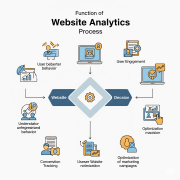
What Website Analytics Can Reveal About Suspicious Activity
- Home Web Development What Website Analytics Can Reveal About Suspicious Activity
The trick is to implement the appropriate analytics suite. Real-time tracking of unusual usage can be facilitated by tools such as Google Analytics, Hotjar, or more sophisticated custom telemetry systems. Here’s how:
 Keep track of player actions, such as button presses, page changes, or feature utilization. Unexpected increases or low participation in predicted areas (such as tutorials) may be signs of bot or cheating activity.
Keep track of player actions, such as button presses, page changes, or feature utilization. Unexpected increases or low participation in predicted areas (such as tutorials) may be signs of bot or cheating activity.
You can visually examine user sessions with these tools. Cheaters could employ repeating patterns or navigate in a different way than normal users.
Funnels illustrate how users proceed along anticipated routes (login → instructional → match queue, for example). Players who skip steps may be abusing shortcuts or manipulating progression with scripts.
READ ALSO: Creating a Website for Modding Enthusiasts: What MelonLoader’s Success Teaches Us
Analytics tool data can be fed straight into anti-cheat software. For instance, you can flag an account for review or temporarily disable it for verification if a user clicks more quickly than a human could react.
Furthermore, bot farms or networks disseminating undetected gaming cheats can be found with the aid of IP tracking, user-agent detection, and referral source monitoring.
When creating games or gaming platforms, web developers need to go beyond superficial safeguards. Instead of waiting for exploits to appear, analytics provides a proactive method to cheat detection by discovering risks through data. You can make gaming environments smarter and safer by seeing and understanding player behavior, not simply what they click.